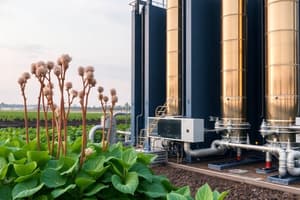Podcast
Questions and Answers
What are the primary types of CO2 storage options mentioned in the text?
What are the primary types of CO2 storage options mentioned in the text?
- Dissolution type, natural CO2 sources, and immiscible CO2 flooding
- Lake type, subsurface mineralisation, and surface waste materials
- Enhanced oil recovery, unminable coal seams, and saline aquifers
- Ocean storage, mineral carbonation, and geological storage (correct)
Which project is cited as an example of immiscible CO2 flooding?
Which project is cited as an example of immiscible CO2 flooding?
- Denver Unit of Wasson Field
- Great Plains / Weyburn project (correct)
- SACROC unit
- Sleipner, Norway
What is the primary method of tertiary recovery (EOR) mentioned in the text?
What is the primary method of tertiary recovery (EOR) mentioned in the text?
- Foam injection
- Waterflooding
- Natural CO2 sources
- Miscible gas injection (correct)
What is the focus of CO2 flooding in EOR?
What is the focus of CO2 flooding in EOR?
What are the sources of CO2 for CO2 EOR projects in the USA?
What are the sources of CO2 for CO2 EOR projects in the USA?
What does the relationship between injected solvent volume and incremental recovery factor indicate?
What does the relationship between injected solvent volume and incremental recovery factor indicate?
What is the focus of laboratory coreflood studies on miscible solvent for oil recovery?
What is the focus of laboratory coreflood studies on miscible solvent for oil recovery?
What is the primary purpose of CO2 sequestration for EOR?
What is the primary purpose of CO2 sequestration for EOR?
What is the estimated total storage capacity of CO2 in the Weyburn Field?
What is the estimated total storage capacity of CO2 in the Weyburn Field?
What is the break-even cost for Advanced CO2-EOR?
What is the break-even cost for Advanced CO2-EOR?
Flashcards are hidden until you start studying
Study Notes
Carbon Capture and Storage (CCS) and Enhanced Oil Recovery (EOR) Key Points
- Immiscible CO2 flooding examples include SACROC unit and Denver Unit of Wasson Field
- USA is not mentioned as a planned CCS hub
- CO2 sequestration for EOR is primarily to enhance oil recovery
- Natural gas injection is not mentioned as a type of CO2 storage
- Coal bed methane production involves CO2 storage in un-minable coal seams
- Natural gas injection is not mentioned as a method of primary, secondary, or tertiary recovery
- The objective of 'Advanced' CO2-EOR is to maximize CO2 sequestration and offset costs by producing oil
- The break-even cost for Advanced CO2-EOR is $22$32 / Tonne of CO2
- Tax credits for CO2 permanently stored and used in EOR are $85 per tonne and $60 per tonne respectively
- The proposed Midwest CO2 Superhighway is expected to sequester up to 40 million tonnes of CO2 annually
- Water Drive is the primary recovery method using the reservoir's own energy
- The estimated total storage capacity of CO2 in the Weyburn Field is approximately 55 Mt CO2
Studying That Suits You
Use AI to generate personalized quizzes and flashcards to suit your learning preferences.





